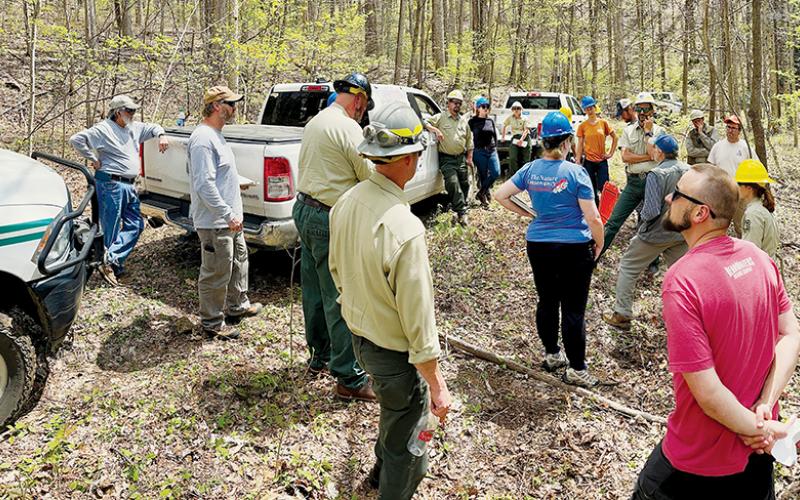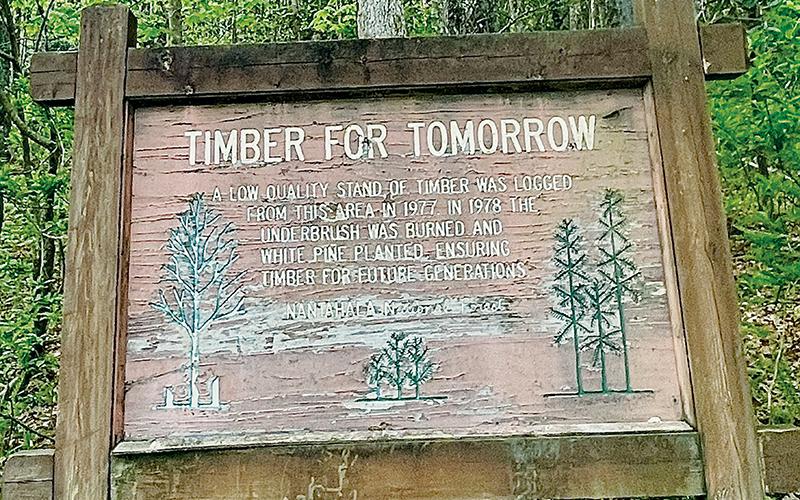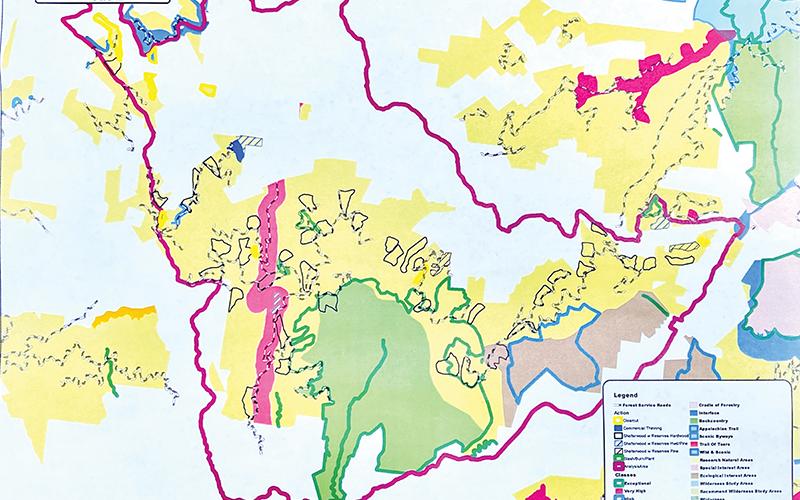Topton – There is a weathered wooden sign on a rutted turnout off U.S. Highway 129 southeast of Robbinsville that tells part of a story.
“Timber for tomorrow,” the sign reads. “A low quality stand of timber was logged from this area in 1977. In 1978 the underbrush was burned and white pine planted, ensuring timber for future generations.”
The concept of same-age stands of commercially viable white pine has fallen out of favor. It is no longer seen as a healthy way to manage forests.
Now, silviculture experts want to restore diversity to the woods, including ridding the forest of even-age managed timber – including the woods described in the “Timber for tomorrow” sign, which will be taken down or replaced once the forestry work is completed.
The Crossover Project analysis area is 16,378 acres of National Forest System lands in the eastern Snowbird Mountains between Andrews and Robbinsville. A small portion of the area will be directly affected by this project, but the benefits will be widespread, U.S. Forest Service officials contend.
The project is focused on conserving forest resources and improving recreation, fish and wildlife habitat, and diversity in age and structure of the forest.
On April 22, the U.S. Forest Service spearheaded a tour of part of the project area for a dozen or so people including environmentalists, wildlife proponents, local government officials, and representatives of the logging industry.
About 10,000 acres in the analysis area are suitable for active management, said Andy Gaston, district ranger for the Cheoah Ranger District of the Nantahala National Forest.
The study identified areas that are suitable for logging as well as old growth and old growth-like stands that are worth preserving.
The plan has been in the works since the mid-teens with progress stalled by COVID-19, Gaston said. Once in place, the project will take three to five years to complete, not counting post-timber-harvest work.
The project includes the construction of temporary logging roads where needed. Younger stands of timber planted by loggers in the mid-20th century and earlier will be thinned, with some trees left standing to become future old growth. New trees more appropriate to the region will be planted, and understory – the ground cover upon which much wildlife needs to survive – will be nurtured and allowed to flourish.
This will allow not only the forest to recover from previous forest management practices, but also improve habitat for animals and birds like the golden-winged warbler and ruffed grouse, two bird species that have experienced declines.
A much larger forest management plan that is being developed called Alternative E is described as a larger version of the Crossover Project. Alternative E, which encompasses both Nantahala and Pisgah national forests, would allow logging of 459,000 acres throughout the two forest systems.
Graham County Commissioner Dale Wiggins participated in the April 22 tour of the Crossover Project area.
“Crossover reveals how unbelievably complex timber harvest sales can be,” Wiggins told The Graham Star following the tour.
“We’re into this five years and still a year away from actual sales.”
Wiggins believes the timber harvests won’t have much of an effect on local jobs. It has been decades since Graham County has had any significant timber harvesting, and he doubts that there are few people of working age who possess the necessary skills. Likewise, there are no sawmills left in Graham County to process the logs, so the harvested timber will likely be trucked out of the area.
On the other hand, the “stumpage fee” – money that logging outfits pay for the right to harvest timber on National Forest land – could benefit Graham. County Schools, as was once the case.
Wiggins is concerned that concerns from more strident environmentalists – who tend to favor restrictions on how forest lands can be used – may find favor over “people like me, who support multiple uses.”
As for “old growth” – trees that somehow survived intensive logging in the county in the 19th and 20th centuries – he doubts that much of it exists beyond what is already projects, such as old growth stands at Joyce Kilmer Memorial Forest.
“The county has been logged through and through,” he said.
Wiggins said 1/4 of Nantahala National Forest is in Graham County – and the county is about 2/3 national forest – so how that land is used has big impacts on Graham County’s economic health and its governments’ ability to pay for the services they provide.
When it comes to Forest Service funding, he said Graham County gets the “short end of the stick.”
In Buncombe County – where the regional office is – Pisgah National Forest is flush with funds for a wide range of improvements.
In Graham County, a campground – Cable Cove – was closed, and forest service roads get a couple thousand dollars a year for clearing and maintenance, he said.



